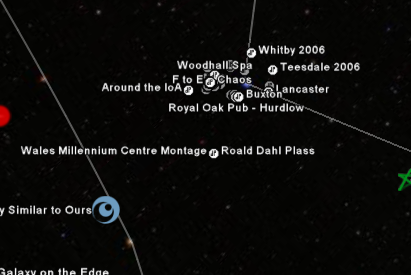Google Sky: A new star cluster is found
I've had another quick play with Google Sky and just noticed something slightly amusing.
Back in January this year, while following a friend's lead, I added a Google Earth feed to my gallery of photographs. It's nothing that clever, it simply adds a little icon  to places I've taken photographs at and you can click through to see each album.
to places I've taken photographs at and you can click through to see each album.
I've got that feed enabled in my copy of Google Earth.
So, there I am, scanning around the sky, seeing what there is to see inside Google Sky itself, and I notice lots of little white dots. Not stars, but tiny little while icons, different from the coloured ones I'd noticed earlier on. I click on one and it splits apart into a handful of little white icons (the usual thing that Google Earth does if multiple items exist in the same place).
So I zoom in, and suddenly I realise what it is I'm seeing:

It seems that the feed for my photographs is still live when in sky mode. It's not obvious to me if this is a bug with my feed, or a bug with Google Earth/Sky. What I do know is that if I turn on the feed from my Panoramio photographs (to use a different example) I see the same effect (although I get thumbnails from there, not my own icon, obviously).





3 comments:
Hey Dave - I've been playing around with Google Sky this afternoon too and a lot of fun it is indeed. I've found the same bug that you mention and so it is definitely associated with Google Sky/Earth - a lot of the tags that I have added in during my time with Google Earth are appearing in strange places in the sky!
Odd, isn't it? It seems like the sort of thing that would have been so obvious to notice.
Still, this is a beta version (so I guess that means I should really be reporting this somewhere) and doubtless it's the sort of thing that'll be addressed pretty soon.
Seems like the sort of thing that needs some sort of "hint" in KML files to say what "mode" they can and should be used in, with the default being "Earth mode only", or something.
Well, I finally found the documentation and, not only does it use some kind of "hint", it actually does use an attribute called hint :-)
Post a Comment